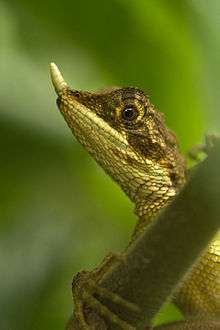Rhino-horned lizard
| Rhino-horned lizard | |
|---|---|
 | |
| Scientific classification | |
| Kingdom: | Animalia |
| Phylum: | Chordata |
| Subphylum: | Vertebrata |
| Class: | Reptilia |
| Order: | Squamata |
| Suborder: | Iguania |
| Family: | Agamidae |
| Subfamily: | Draconinae |
| Genus: | Ceratophora |
| Species: | C. toddartii |
| Binomial name | |
| Ceratophora stoddartii Gray, 1834 | |
The rhino-horned lizard (Ceratophora stoddartii) is a species of lizard in the Agamidae family. It is endemic to Sri Lanka. It is called kagamuva angkatussa-කගමුව අං කටුස්සා in Sinhala.
Habitat and distribution
Widespread from montane forests of central Sri Lanka. Localities include Nuwara Eliya, Hakgala, Pattipola, Ohiya, Horton Plains, Hewaheta, Dimbula, Agarapathana and Adam's Peak.
Description
Head is oval, and longer than wide. Rostral appendage is long, horn-like, about two thirds the length of the snout in males, which is reduce or even absent in females. Lamellae under fourth toe numbering 23–27. Dorsum brownish green or yellowish brown. Tail with 10–16 dark brown bands. Venter light brownish gray.
Ecology and reproduction
A slow moving, arboreal species, found on trees from 1 to 2 m above ground. When threatened, it opens its mouth wide, revealing the bright orange linings on the oral cavity. Egg laying taken place in July, and about 2–5 eggs, measuring 7.6-8.1 * 13.5–14.5mm. They are deposited in a hole, and hatch after 81–90 days, although hatchlings once have been founded in wild also during colder months such as December and January.
See also
- Horton Plains National Park
- http://reptile-database.reptarium.cz/species?genus=Ceratophora&species=stoddartii
- http://lankanaturesummary.blogspot.com/2014/02/ceratophora-stoddartii-rhino-horned.html
| Wikimedia Commons has media related to Ceratophora stoddartii. |